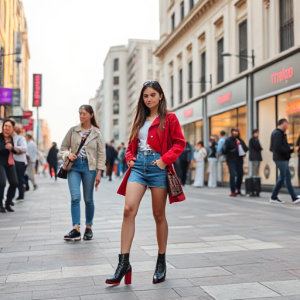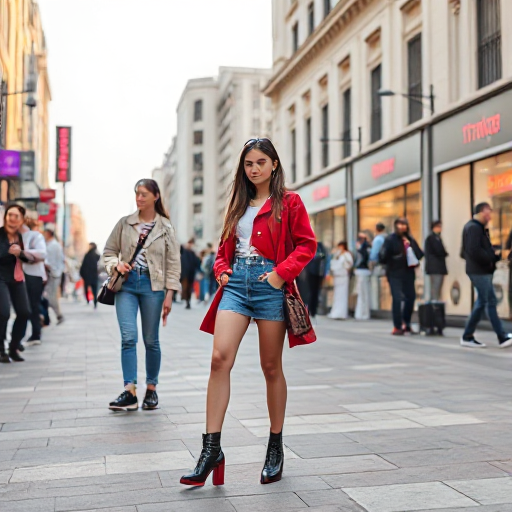
TikTok has rapidly transformed from a fun social media platform for short videos to a global marketing powerhouse, with over a billion active users worldwide. Among the many industries leveraging TikTok’s viral potential, the fashion industry stands out. As fashion brands aim to engage younger, trend-savvy audiences, TikTok presents a unique opportunity to blend entertainment with commerce. This article will explore TikTok fashion marketing, its key strategies, and how brands can effectively tap into the platform’s power to increase their reach and sales.
Why TikTok is a Game-Changer for Fashion Marketing
TikTok’s success lies in its algorithm, which encourages content discovery and viral trends, and its user base, which consists predominantly of Gen Z and Millennials. These two generations are highly active on the platform and are shaping the future of fashion by prioritizing individuality, sustainability, and authenticity in their purchasing decisions.
- Massive User Base: As of 2025, TikTok boasts over a billion active users, with a significant portion of these users falling within the 16-34 age range. These users are highly engaged and spend an average of 52 minutes per day on the platform. This gives fashion brands an unparalleled opportunity to reach their target audience through organic content or paid advertisements.
- Short-Form Content: TikTok is all about short-form video content, with a maximum length of 10 minutes. This encourages creativity, making it easier for fashion brands to showcase their products in fun, innovative, and visually appealing ways.
- User-Generated Content and Trends: TikTok is driven by trends, many of which are user-generated. Fashion brands can capitalize on trending challenges, viral sounds, and meme culture to connect with audiences in a more organic, relatable way. The platform thrives on user interaction, and content that resonates with the audience often goes viral, creating buzz around products or brands.
- Influencers and Creators: TikTok is home to a new wave of influencers who have massive followings. Many fashion brands collaborate with TikTok influencers to create sponsored content, unboxing videos, try-ons, or simply feature products in a more authentic way. This form of marketing can drive sales directly through affiliate links, brand partnerships, or promotional codes.
Key Strategies for Fashion Marketing on TikTok
To leverage TikTok effectively for fashion marketing, brands need to understand its unique features and adapt their strategies accordingly. Here are some key strategies to consider:
1. Create Trend-Driven Content
The TikTok algorithm heavily favors content that taps into trends. Participating in viral challenges, using popular music tracks, and employing trending hashtags can give fashion content an edge. However, it’s important for brands to stay true to their image while jumping on these trends.
For example, a fashion brand could showcase their products in a TikTok dance video, or they could creatively style outfits based on the latest viral fashion trend. It’s all about balancing brand identity with fun, engaging content that fits seamlessly into TikTok’s culture.
2. Leverage User-Generated Content (UGC)
User-generated content is one of the most authentic forms of marketing on TikTok. Fashion brands can encourage their followers to post videos of themselves wearing the brand’s products by offering incentives like discounts or by running contests. UGC not only promotes brand awareness but also creates a sense of community around the brand.
Additionally, TikTok’s “Duet” feature allows users to create content alongside original videos. Brands can engage with users by duetting their UGC or asking fans to duet with brand posts.
3. Influencer Collaborations
Working with TikTok influencers can provide fashion brands with instant credibility and access to a wider audience. Fashion influencers, also known as “fashion TikTokers,” have dedicated followings who trust their style recommendations. Collaborations can range from sponsored videos, product placements, to influencer-hosted giveaways.
Influencers can creatively integrate fashion items into their daily routines, providing social proof that their followers can relate to. Micro-influencers, in particular, are highly effective as they tend to have a niche audience that is more engaged and likely to convert.
4. Shoppable TikTok Videos
One of the most exciting features of TikTok for fashion brands is the ability to sell products directly on the platform. TikTok has introduced native shopping features, such as TikTok Shopping, which allows brands to link their e-commerce store directly to their TikTok profile. When a product is featured in a video, viewers can easily tap on it to make a purchase without leaving the app.
Brands can also integrate product links into their live stream videos, allowing users to shop in real-time while interacting with content. This feature simplifies the buying process and can significantly increase conversion rates.
5. Utilize TikTok Ads
TikTok offers several types of advertisements to help fashion brands boost visibility:
- In-Feed Ads: These ads appear on the “For You” page, blending in seamlessly with user-generated content.
- Branded Hashtag Challenges: This type of ad encourages users to create content around a specific theme or hashtag. Fashion brands can challenge users to show how they style their clothing, for example.
- TopView Ads: These full-screen ads appear when users open the app, ensuring maximum visibility.
- Branded Effects: Fashion brands can create custom filters or effects for users to interact with, creating an immersive experience.
TikTok ads allow for targeted marketing, with options to reach users based on their location, interests, or behavior. With this, fashion brands can ensure their content reaches the right audience.
6. Storytelling and Authenticity
In the fast-paced world of TikTok, authenticity is crucial. Fashion brands should aim to create genuine, relatable content that resonates with users rather than focusing solely on polished, aspirational imagery. TikTok users appreciate raw, behind-the-scenes moments, and brands can capitalize on this by sharing their creative process, challenges, or day-to-day operations.
For example, a clothing brand could showcase the process of designing a new collection, highlight the sustainability efforts in their manufacturing process, or feature real customers and employees wearing their clothes. Storytelling helps build a connection between the brand and its audience, which fosters trust and loyalty.
Case Studies of Successful Fashion Marketing on TikTok
- Aerie Aerie, a lingerie brand under American Eagle, used TikTok to create a body-positive movement, which resonated with their audience. Their #AerieREAL campaign invited users to post unfiltered videos, celebrating real bodies and natural beauty. The campaign went viral, generating massive engagement and driving sales.
- Guess Guess collaborated with influencers and launched a #InMyDenim hashtag challenge. The challenge encouraged users to show off their unique denim styles, resulting in millions of views and widespread brand awareness.
- Shein Shein, a fast-fashion retailer, has mastered TikTok marketing by collaborating with influencers to promote trendy, affordable clothing. They created viral unboxing and try-on hauls, which received significant engagement. Shein’s success on TikTok highlights the power of influencer partnerships combined with accessible, affordable fashion.
TikTok is a game-changer in fashion marketing, offering brands the chance to reach younger audiences in creative, engaging, and authentic ways. By leveraging trends, influencers, and user-generated content, fashion brands can cultivate strong connections with their audience. With the addition of shoppable videos and integrated ads, TikTok is revolutionizing how fashion is marketed and sold online.
For fashion brands looking to stay relevant, adopting a TikTok marketing strategy is no longer optional—it’s essential. By embracing TikTok’s unique features and understanding its audience, fashion brands can position themselves for long-term success in a rapidly evolving digital landscape.
